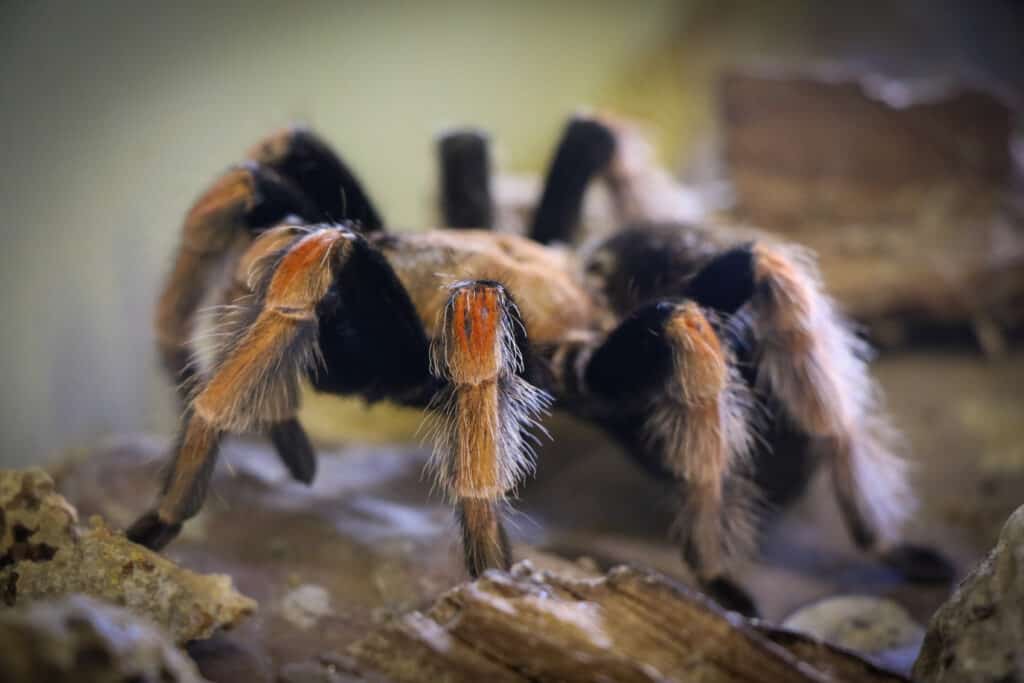Mexican fireleg tarantulas have bright reddish-orange legs.
Advertisement
Mexican Fireleg Tarantula Scientific Classification
- Kingdom
- Animalia
- Phylum
- Arthropoda
- Class
- Arachnida
- Order
- Araneae
- Family
- Theraphosidae
- Genus
- Brachypelma
- Scientific Name
- Brachypelma boehmei
Read our Complete Guide to Classification of Animals.
Mexican Fireleg Tarantula Conservation Status
Mexican Fireleg Tarantula Facts
- Prey
- insects, lizards, small mice, small birds, crickets
- Main Prey
- insects
- Name Of Young
- spiderlings
- Group Behavior
- Solitary
- Fun Fact
- Mexican fireleg tarantulas have bright reddish-orange legs.
- Biggest Threat
- Over harvesting for the pet trade
- Most Distinctive Feature
- Black body and reddish-orange legs
- Other Name(s)
- Mexican rustleg tarantula
- Temperament
- Docile but a bit skittish
- Habitat
- desert scrub land and forests
- Predators
- snakes, lizards, birds, tarantula hawk (wasp)
- Diet
- Carnivore
- Lifestyle
- Nocturnal
- Location
- Guerrero, Mexico
View all of the Mexican Fireleg Tarantula images!
A close relative of the Mexican redknee tarantula.
Mexican fireleg tarantula are bright orange, red and black tarantulas from southern Mexico. They are related to one of the most commonly recognized tarantulas, the Mexican redknee. These medium-sized tarantulas live in the desert scrub along the Pacific coast and make burrow in the ground where they hide out during the day and come out at night. They are one of the more common tarantulas kept as pets due to their firery red and orange coloration.
Amazing Mexican Fireleg Tarantula Facts
- They live in southern Mexico in the state of Guerrero.
- Their bodies are black with orange legs and bright red knees.
- Because of their docile nature they are kept as pets.
- Females can live to be 20-25 years old.
- If they are startled or threatened they will flick their urticating hairs in self-defense.
Mexican Fireleg Tarantula Scientific Name
The scientific name of the Mexican fireleg tarantula is Brachypelma boehmei. The name comes from the Greek words Brachys meaning “short” and pelma meaning the “sole of the foot”. The term boehmei comes from the first collector that imported the spider, K. Bohme. They are related to the Mexican redknee and look very similar, but they do have a different coloration and are a little larger. They are also sometimes called Mexican rustleg.
Mexican Fireleg Tarantula Appearance

The bright orange of these tarantulas legs is quite remarkable especially when in contrast to their dark black bodies.
©5,472 × 3,648 pixels, file size: 5.45 MB, MIME type: image/jpeg – License
The bright orange of these tarantulas legs is quite remarkable especially when in contrast to their dark black bodies. The firs section of their jointed legs is reddish then fades a bit to orange for the other joints and ends with black feet. Mexican Firelegs are good-sized tarantula with bodies that are 2-3 inches long and a leg span of 5-6 inches. If you look at your hand, the average human male hand is about 3.5 inches across and the average female’s is around 3.1 inches (according to a study by NASA), so that is about how long these spiders get, plus add in their leg span.
Their bodies and legs are covered in bristle like hairs that are called setae. On top of their heads are 8 eyes with the two center eyes being larger. At the front of their head are what look like two additional legs, these appendages are called pedipalps. They are used in a similar fashion as arms with both female and male using them to help capture and hold prey. Males use them additionally during the mating process. Another prominent feature is the tarantula’s fangs. While most spiders have mouth parts that operate sideways, tarantulas have a bite that is up and down. Their fangs do have venom that they use to stun their prey.
Mexican Fireleg Tarantula Behavior
While their related Mexican redknee tarantulas are very docile (some pet owners describe them as “living rocks” with them finding one spot in their enclosure and staying there…for days) Mexican Firelegs are a little more spirited and may scurry about more than Mexican redknees. In the wild they can spend extended periods of time deep in their burrows. On a daily basis they spend their days in the ground in their burrows which they dug or found abandoned by another animal. At night they come out to hunt by hiding in the opening of their burrow and wait for prey to pass by.
If they feel threatened or are startled they will flick their urticating hairs on the predator or threat. These tiny hairs are very irritating especially if they get in the eyes. If you choose to handle one as a pet it is advised to wear gloves to avoid contact of the bristles with your skin. Be sure to keep them away from your face and eyes as well.
The way tarantulas make room for their growing bodies is by molting their old exoskeleton to make room for the new one. They molt more frequently when they are younger and then around once a year as adults. Compared to other tarantulas, they are slow growers and may not molt as often as others.
Mexican Fireleg Tarantula Habitat
Mexican fireleg tarantulas are from the state of Guerrero in Mexico and they live along the Pacific coast in dry scrub land (desert like with brush, bushes, and other sparse vegetation) and forest floors. They live one spider to a burrow and live pretty solitary lives. The burrows are in the ground and sometimes hidden under bushes or fallen tree branches. The doorway of the burrow is usually covered with a spider web. They do not go overboard with their webbing like some tarantulas but do use their webs to protect the entrance of their homes.
The climate in Mexico where they live is warm and humid with temperatures from the low seventies to the mid eighties. In the wild they adjust to the weather by staying hidden during the day and moving deeper in their burrows when needed to find cooler temps.
Mexican Fireleg Tarantula Predators and Threats
The main predators of Mexican fireleg tarantulas need to watch out for are larger spiders, lizards, snakes and birds. Mexican firelegs need to protect themselves from predators by hiding in burrows during the day and creating webs over the entrance to their burrow to deter predators.
If threatened they typically flee first making a byline for their burrow. If cornered they will flick their urticating hairs at a predator. They can use their fangs to fight back and bite releasing a mild venom.
What Eats Mexican Fireleg Tarantulas?
The animals that eat Mexican Fireleg tarantulas are snakes, lizards, birds and larger spiders. The biggest threat to them is the Pepsis wasp, which is also called the tarantula hawk. They target tarantulas by swooping down and stinging them, paralyzing them but keeping them alive. They then inject one egg into their abdomen and bury them alive. Then the new wasp hatches and it eats the tarantula as its first meal (and a few meals thereafter). These wasps are also huge, around 2 inches long with brightly colored blue bodies and burnt orange wings.
What Do Mexican Fireleg Tarantulas Eat?
Mexican fireleg tarantulas eat insects, frogs, lizards, small birds, worms and small mice. They wait in their burrows for prey to pass by and when they feel the vibrations of an approaching animal they lurch out and snag it. They quickly inject it with venom and ball it up with their webs. Their digestive juices liquefy the prey and they suck it up with a straw-like mouth.
What is the Conservation Status of Mexican fireleg Tarantulas?
Mexican fireleg tarantulas are listed as “Endangered” by the IUCN. They are also listed in Appendix II of the Convention of International Trade in Endangered Species (CITES). The major threats include habitat loss due to urbanization and agriculture, the increase demand in the pet trade, and number that are run over by cars during the mating season. Although the number of captive-bred Mexican firelegs seemed to be suitable for awhile there seems to be an increase in demand. Their populations are being monitored to be sure they are not over caught.
Reproduction, Babies, and Lifespan
Mexican fireleg tarantulas mate in the fall and the females create an egg sac in the spring. The males leave their burrows in search of female and may tap on the ground outside her burrow to see if she is receptive. The males must pay attention during this time because an unreceptive female can try to quickly eat him. If the female is receptive she will come out of her burrow and the male will spin a sperm web. He will deposit his sperm on the web and then transfer it to the female.
Female Mexican fireleg tarantulas lay around 200-400 eggs. She will keep the egg sac in her burrow, keeping it safe and periodically rotating the sac to be sure as many eggs as possible get fertilized. After the eggs hatch they remain with the mother for a few more weeks before going out on their own.
Males have a much shorter life span than females with males averaging 7-8 years and females 20-25 years. If males do not get eaten during mating then they typically only live a few more months at most before their life cycle ends.
Population
The population of Mexican fireleg tarantulas is uncertain but the IUCN is concerned about the habitat loss of the limited range of these tarantulas. They have listed them as “Endangered” and they are not allowed to be exported from Mexico. They are also listed in Appendix II of the CITES in an effort to protect their decreasing population.
Related Animals
View all 164 animals that start with MMexican Fireleg Tarantula FAQs (Frequently Asked Questions)
Are Mexican fireleg tarantulas venomous?
They are venomous but their venom is not harmful to humans. There are very few incidents of bites recorded.
How big do Mexican fireleg tarantulas get?
Their bodies are around 2 ½-3 inches long with the females having a leg span of 5-6 inches and the males being a bit smaller.
Do Mexican fireleg tarantulas make webs?
Yes, they make webs to cover their burrow, but they do not catch insects in their webs like other spiders.
Where are Mexican fireleg tarantulas found?
They are native to desert and forests of Guerrero, Mexico.
Are Mexican fireleg tarantulas good for beginners?
Yes, they are easy to care for and can live for 20-25 years (the females).
Thank you for reading! Have some feedback for us? Contact the AZ Animals editorial team.
Sources
- University of Nebraska Lincoln / Distance Master of Science in Entomology Projects, Available here: https://digitalcommons.unl.edu/cgi/viewcontent.cgi?referer=&httpsredir=1&article=1000&context=entodistmasters
- Red List / BirdLife International , Available here: https://www.iucnredlist.org/species/66081558/148681774#population
- The Tarantula Collective, Available here: https://www.thetarantulacollective.com/caresheets/brachypelma-boehmei
- Tarantulas.com, Available here: http://www.tarantulas.com/caresheets/B_boehmei.html

















